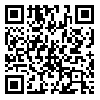Sun, Nov 23, 2025
Volume 35, Issue 4 (9-2025)
JHNM 2025, 35(4): 323-331 |
Back to browse issues page
Download citation:
BibTeX | RIS | EndNote | Medlars | ProCite | Reference Manager | RefWorks
Send citation to:



BibTeX | RIS | EndNote | Medlars | ProCite | Reference Manager | RefWorks
Send citation to:
Atashbahar O, Moqaddasi Amiri M, Naderi Z, Sadeghi R, Negahdari F. Childbearing Intention and the Related Psychosocial Factors: A Cross-sectional Study. JHNM 2025; 35 (4) :323-331
URL: http://hnmj.gums.ac.ir/article-1-2232-en.html
URL: http://hnmj.gums.ac.ir/article-1-2232-en.html
Omolbanin Atashbahar1 

 , Mohammad Moqaddasi Amiri1
, Mohammad Moqaddasi Amiri1 

 , Zeinab Naderi2
, Zeinab Naderi2 

 , Reza Sadeghi *3
, Reza Sadeghi *3 

 , Fatemeh Negahdari4
, Fatemeh Negahdari4 




 , Mohammad Moqaddasi Amiri1
, Mohammad Moqaddasi Amiri1 

 , Zeinab Naderi2
, Zeinab Naderi2 

 , Reza Sadeghi *3
, Reza Sadeghi *3 

 , Fatemeh Negahdari4
, Fatemeh Negahdari4 


1- Assistant professor, Department of Public Health, Sirjan School of Medical Sciences, Sirjan, Iran
2- Assistant Professor, Department of Nursing, Sirjan School of Medical Sciences, Sirjan, Iran.
3- Associate professor, Department of Public Health, Sirjan School of Medical Sciences, Sirjan, Iran. ,reza.sadeghi351@yahoo.com
4- Public Health (BSc), Student Research Committee, Sirjan School of Medical Sciences, Sirjan, Iran.
2- Assistant Professor, Department of Nursing, Sirjan School of Medical Sciences, Sirjan, Iran.
3- Associate professor, Department of Public Health, Sirjan School of Medical Sciences, Sirjan, Iran. ,
4- Public Health (BSc), Student Research Committee, Sirjan School of Medical Sciences, Sirjan, Iran.
Abstract: (263 Views)
Introduction: Planning and policy-making for population growth according to sustainable development requires a comprehensive and deep study of childbearing behaviors and considering all important effective factors.
Objective: This study aimed to investigate childbearing intention and the related psychosocial factors in Sirjan city, south of Iran.
Materials and Methods: This descriptive-analytical study employed a cross-sectional design, involving 386 married women and men whose wives were at the reproductive age (15-49 years), who were selected from healthcare centers in Sirjan city in 2022 using a random cluster sampling method. Data were collected using a sociodemographic form, the Attitudes toward Fertility and Childbearing Scale (AFCS), Billari’s Subjective Norms (SN) questionnaire, the Multidimensional Scale of Perceived Social Support (MSPSS), the Adult Hope Scale (AHS), the ENRICH Marital Satisfaction Scale (EMS), and one childbearing intention question. Data analysis was done using descriptive and analytical statistics (independent t-test, one-way analysis of variance, Tukey’s post hoc test, and multiple linear regression analysis).
Results: Most of the participants were female (93.5%), 29-33 years old (28.2%), with a bachelor’s degree (44.1%), and were housekeepers (57.5%). Among the participants, 165 (46.1%) did not have a tendency, 69(19.3%) were hesitant, and 124(34.6%) had a tendency towards childbearing. There was a significant difference in childbearing intention based on age (P=0.003), AFCS score (P=0.001), and SN score (P=0.001), but the difference was not significant based on the MSPSS, AHS, or EMS scores (P>0.05). The multiple linear regression model showed that the monthly income level >300 dollars was significantly associated with the AHS score (P=0.022); with every one-unit increase in the monthly income level >300 dollars, the hope for childbearing increases by 4.66 units (B=4.66, 95% CI; 0.67%, 8.65%).
Conclusion: Based on the findings, Iranian officials are recommended to formulate population growth policies based on the childbearing attitudes and SN of people, resulting from the shift to a modern lifestyle.
Objective: This study aimed to investigate childbearing intention and the related psychosocial factors in Sirjan city, south of Iran.
Materials and Methods: This descriptive-analytical study employed a cross-sectional design, involving 386 married women and men whose wives were at the reproductive age (15-49 years), who were selected from healthcare centers in Sirjan city in 2022 using a random cluster sampling method. Data were collected using a sociodemographic form, the Attitudes toward Fertility and Childbearing Scale (AFCS), Billari’s Subjective Norms (SN) questionnaire, the Multidimensional Scale of Perceived Social Support (MSPSS), the Adult Hope Scale (AHS), the ENRICH Marital Satisfaction Scale (EMS), and one childbearing intention question. Data analysis was done using descriptive and analytical statistics (independent t-test, one-way analysis of variance, Tukey’s post hoc test, and multiple linear regression analysis).
Results: Most of the participants were female (93.5%), 29-33 years old (28.2%), with a bachelor’s degree (44.1%), and were housekeepers (57.5%). Among the participants, 165 (46.1%) did not have a tendency, 69(19.3%) were hesitant, and 124(34.6%) had a tendency towards childbearing. There was a significant difference in childbearing intention based on age (P=0.003), AFCS score (P=0.001), and SN score (P=0.001), but the difference was not significant based on the MSPSS, AHS, or EMS scores (P>0.05). The multiple linear regression model showed that the monthly income level >300 dollars was significantly associated with the AHS score (P=0.022); with every one-unit increase in the monthly income level >300 dollars, the hope for childbearing increases by 4.66 units (B=4.66, 95% CI; 0.67%, 8.65%).
Conclusion: Based on the findings, Iranian officials are recommended to formulate population growth policies based on the childbearing attitudes and SN of people, resulting from the shift to a modern lifestyle.
Article Type : Research |
Subject:
General
Received: 2023/10/6 | Accepted: 2025/05/6 | Published: 2025/09/8
Received: 2023/10/6 | Accepted: 2025/05/6 | Published: 2025/09/8
Send email to the article author
| Rights and permissions | |
 | This work is licensed under a Creative Commons Attribution-NonCommercial 4.0 International License. |



